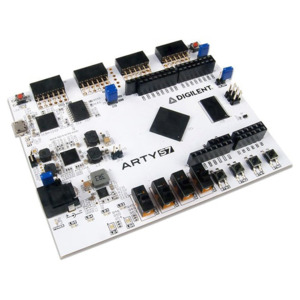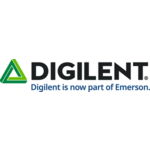
- Description
- Specifications
- Documents
Digilent Arty S7-50 Spartan-7 FPGA Development Board
Arty S7-50 Specifications
- FPGA part: XC7S50-CSGA324
- 1 MSPS On-chip ADC: Yes
- Logic Cells: 52,160
- Slices: 8,150
- Flip-flops: 65,200
- DSP Slices: 120
Series Features and Specifications
- FPGA Features
- Internal clock speeds exceeding 450MHz
- On-chip analog-to-digital converter (XADC)
- Programmable over JTAG and Quad-SPI Flash
- System Features
- 256 MB DDR3L with a 16-bit bus at 325 MHz (650 MT/s)
- 128 Mbits Quad-SPI Flash
*Due to supply chain constraints, either the S25FL127S or S25FL128S Flash Memory may be loaded on your board. These parts are not functionally equivalent, but flash programming through Vivado and the QSPI boot mode are not affected. More information can be found on digilent.com - 100 MHz External Clock
- USB-JTAG Programming circuitry (Micro B USB cable required but not included)
- Powered from USB or any 7V-15V source
- System Connectivity
- USB-UART Bridge
- Interaction and Sensory Devices
- 4 Switches
- 4 Buttons
- 1 Board Reset Button
- 1 FPGA Reset Button
- 4 Green LEDs
- 2 RGB LEDs
- Expansion Connectors
- 4 Pmod connectors
- Arduino/chipKIT Shield connector
- Product Compliance
- HTC: 8471500150
- ECCN: 5A992.c
Why Choose The Arty S7-50?
The only difference between the Arty S7-50 and Arty S7-25 is the size of the Spartan-7 part. The Spartan-7 FPGAs both have the same capabilities, but the -50 has about a 2 times larger internal FPGA than the -25. The differences between the two variants are summarized below:
| Arty S7-25 | Arty S7-50 |
| FPGA Part Number: XC7S25-1CSGA324C
Look-up Tables (LUTs): 14,600 Flip-Flops: 29,200 Block RAM: 202.5 KB Clock Management Tiles: 3 I/O Pins: 150 Min Package Size: 13x13mm | FPGA Part Number: XC7S50-1CSGA324C
Look-up Tables (LUTs): 32,600 Flip-Flops: 65,200 Block RAM: 337.5 KB Clock Management Tiles: 5 I/O Pins: 250 Min Package Size: 15x15mm |
The board requires either a micro USB cable or 7-15V external power supply to be powered. The external power supply must have a coaxial, center-positive connector with 2.1 mm or 2.5 mm internal diameter.
Arty S7 Series Overview
The Arty S7 board is the newest addition to Digilent's Arty FPGA development board series. The Spartan-7 FPGA, designed with Xilinx's most recent technologies, provides an optimal balance of size, performance, and cost-effectiveness, and is fully compatible with versions 2017.3 and later of the Vivado Design Suite. The integration of this FPGA into the Arty form factor offers users a broad range of I/O and expansion possibilities. Users can utilize the dual-row Arduino connectors to attach any of the numerous compatible hardware shields available, or they can use the Pmod ports with Digilent's ready-made Pmod IP blocks for a more efficient design process. The Arty S7 is designed to be ready for MicroBlaze and comes pre-configured to work with the free Xilinx WebPack license with the Vivado Design Suite.
Programming Software
The Arty S7 can be programmed with Digilent's Adept software. Digilent Adept is a unique and powerful solution which allows you to communicate with Digilent system boards and a wide assortment of logic devices. Find out more about Adept here.
To create and modify designs for your Arty S7, you can use Xilinx's Vivado Design Suite. Vivado is a software designed for the synthesis and analysis of HDL designs. Both variants of the Arty S7 are supported by the free WebPACK edition of the Vivado Design Suite.
If you are using the MicroBlaze Soft Processor Core from Xilinx, you can make use of the Vitis Core Development Kit or Xilinx Software Development Kit to create embedded applications for your Arty S7.
*Note: Xilinx software tools are not available for download in some countries. Prior to purchasing the Arty S7, please check the supporting software's availability, as it is required for the board's use.
What's in the Box
- Arty S7-50 Development Board
